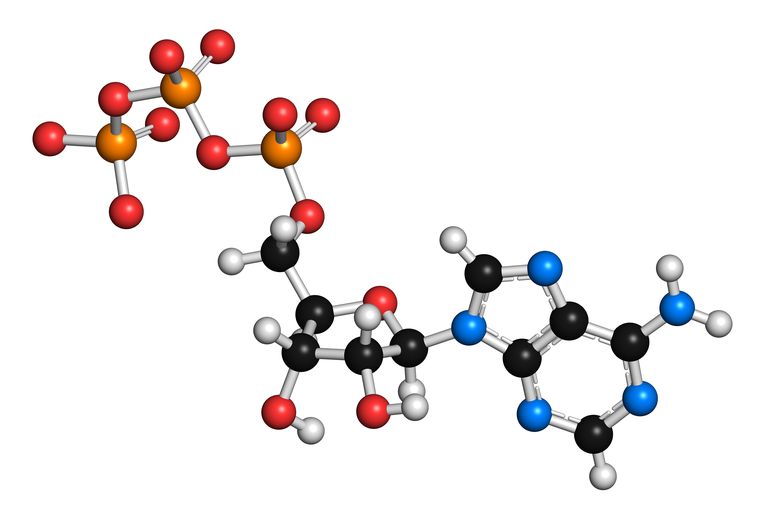The body generates energy in a few different ways. Each energy pathway is engaged at different intensities and durations of exercise. During continual exercise, contributions will be found from all pathways and can fluctuate depending available resources, metabolic training, level of exertion and various other influences (McArdle, Katch, & Katch, 2015).
What is body energy
Energy in the body is mainly found in the form of ATP (adenosine triphosphate). Energy is created from the separation of a phosphate from this molecule. In that moment of separation energy is released and able to be accessed by cells in the surrounding area. The ATP molecule then becomes ADP (adenosine diphosphate) until the removed phosphate is reattached (de Salles, BF. Simão, R. Mirand, F. Novaes, Silva. Lemos & Willardson, 2009). In times of extreme energy demand another phosphate can be separated from the ADP molecule however this is typically only in extreme situations (Baechle & Earle, 2008). Ensuring a constant stream of energy requires the body to constantly be separating and resynthesizing these ATP molecules whenever there is energy demand.
Phosphagen Pathway
The phosphagen pathways is the first energy source called upon at the beginning of any exercise program or in burst movements that are too quick for other systems to be called into action (think jumping out of the way of a car) (McArdle et al., 2015). This system has a molecule called phosphocreatine (PCr). At any given time, there is fully synthesized ATP floating around in tissue cells. When the phosphate is separated PCr immediately donates their phosphate to resynthesizing ATP at a rapid rate. Creatine supplementation is designed to maximize the capacity of the phosphagen pathway by extending its duration and quickening its recovery (Gutierrez-Sancho, 2006).
Although this system is extremely quick to produce energy it is also extremely quick to deplete. At the onset of continual high intensity exercise the phosphagen system pathway is capable of providing energy for a range of 10-30seconds (McArdle et al., 2015). Its goal is to keep the body moving as long as is required for the anaerobic energy system to engage.
Anaerobic pathway
Anaerobic refers to the ability to generate energy in the absence of oxygen. This system relies primarily on glucose and glycogen (sugars) for energy production (Jeukendrup, Asker E., Gleeson, 2010). This energy system engages shortly after the phosphagen pathway and can generate energy for the remaining time required for the oxidative pathway to engage: 60-180 seconds of high intensity work (McArdle et al., 2015).
Anaerobic metabolism breaks down sugars to resynthesize ATP. It is more robust in its ability to maintain energy production compared with the phosphagen system however can become overloaded leading to the buildup of lactate (more on that here)(Borresen & Lambert, 2009). If this buildup gets to be too extreme it will lead to a decreased ability to generate force within the muscles until the body has been able to clear it sufficiently from the area.
Byproducts of the anaerobic system are required to engage the aerobic system. The phenomena of “bonking” is the result of a complete depletion of available carbohydrates leading to a disruption of the oxidative pathway (McArdle et al., 2015). When oxygen is present during the anaerobic system the end products are then transferred to the oxidative pathway allowing for a steadier stream of energy production.
Aerobic Pathway
In the presence of adequate oxygen our bodies are capable of generating an almost endless supply of energy through the burning of fatty acids. An average body 150 pound male stores over 100,000 calories in non-essential body fat (a marathon typically burns 2,600 or so calories) (McArdle et al., 2015). This system is the slowest to engage, often taking upwards of 2 minutes to be fully functional but will allow for continuous exercise as long as the oxygen demands stay within the capabilities of the individual (de Lucas, Dittrich, Junior, de Souza, & Guglielmo, 2012).
Energy from this method, called oxidative phosphorylation, takes place in the mitochondria of the cells. It primarily burns fatty acids stored in the body as adipose tissue (body fat) but can burn protein as well (Smith et al., 2010). Endurance training affects adaptation to this system by increasing blood flow, increasing the number of mitochondria, and increasing the metabolic enzymes (Romijn, Coyle, Sidossis, Zhang, & Wolfe, 1995).
References:
Baechle, T., & Earle, R. (2008). Essentials of Strength and Training and Conditioning (3rd ed.). Champaign, Il: Human Kinetics.
Borresen, J., & Lambert, M. I. (2009). The Quantification of Training Load , Effect on Performance. Sports Medicine, 39(9), 779–95. https://doi.org/10.2165/11317780-000000000-00000
de Lucas, R. D., Dittrich, N., Junior, R. B., de Souza, K. M., & Guglielmo, L. G. A. (2012). Is the critical running speed related to the intermittent maximal lactate steady state? Journal of Sports Science and Medicine, 11(1), 89–94.
de Salles, BF. Simão, R. Mirand, F. Novaes, Silva. Lemos, A., & Willardson, J. M. (2009). Rest Interval between Sets in Strength Training. Sports Medicine, 39(9), 765–777.
Gutierrez-Sancho, O. (2006). The Effects of Creatine Supplementation on Biochemical , Body Conposition , and Performance Outcomes in Humans : A Meta-analysis. … Journal of Applied …, 18(2), 12–38. Retrieved from http://vc.bridgew.edu/mahpls_fac/69/
Jeukendrup, Asker E., Gleeson, M. (2010). Sport Nutrition (2nd ed.). Champaign, Il: Human Kinetics.
McArdle, W., Katch, F., & Katch, V. (2015). Exercise Physiology (8th ed.). Baltimore, MD: Wolters Kluwer.
Romijn, J. A., Coyle, E. F., Sidossis, L. S., Zhang, X., & Wolfe, R. R. (1995). Relationship between fatty acid delivery and fatty acid oxidation during strenuous exercise. American Physiological Society, 1939–1945.
Smith, J. W., Zachwieja, J. J., Péronnet, F., Passe, D. H., Massicotte, D., Lavoie, C., & Pascoe, D. D. (2010). Fuel selection and cycling endurance performance with ingestion of [13C]glucose: evidence for a carbohydrate dose response. Journal of Applied Physiology (Bethesda, Md. : 1985), 108(6), 1520–1529. https://doi.org/10.1152/japplphysiol.91394.2008


0 Comments